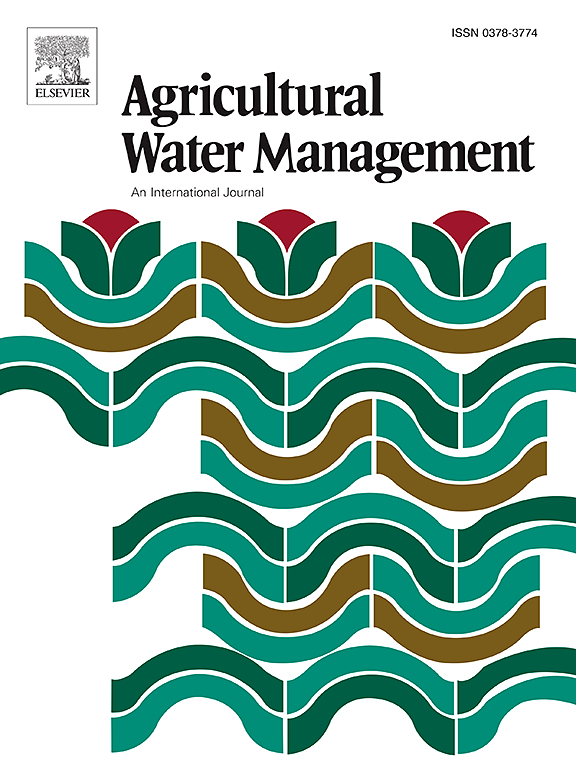模拟雨养棉花叶片和作物水分利用效率:环境和生物物理驱动因素的相互作用
IF 6.5
1区 农林科学
Q1 AGRONOMY
引用次数: 0
摘要
水分利用效率(WUE)是连接植物固碳(光合作用)和水分消耗(蒸腾)的关键生态水文特征,在植物-大气连续体中起着至关重要的作用。然而,不同尺度下WUE的生态驱动因素和尺度关系尚不清楚。本研究旨在模拟雨养棉花在叶片“WUEL”和作物“WUEC”尺度上的水分利用效率,并进一步探讨环境和生物物理因素对水分利用效率动态的影响。利用模拟的叶片和作物水分利用效率通量建立尺度关系。利用改进的Ball-Berry模型模拟了暴露于环境CO2下棉花叶片的气孔导度gs和WUEL,并在中午前后测量了瞬时气体交换,以验证模型的有效性。我们观察到WUEL的大昼夜变化(4.3 ± 1.9 mmolCO2 mol - 1H2O)和季节变化(5.16 ± 1.51 mmolCO2 mol - 1H2O)。模型模拟的gs和WUEL与实测值(ρ>0.5, RMSE<0.3)吻合较好。采用FAO-AquaCrop软件,利用作物周期的气象、物候和管理条件模拟WUEC。通过土壤含水量的重力测量(ρ = 0.95, RMSE = 21.8)和蒸散量的涡动相关(EC)测量(ρ = 0.57, RMSE = 0.88)进行模型校准。作物周期WUEC的季节变化范围为1.7 ~ 7.3 kg/m3。我们观察到,在成熟期(ρ = 0.84)和生长期(ρ = 0.75), WUEL和WUEC之间存在很强的线性关系。考虑了8个气候和生物物理因子在两个尺度上对WUE的依赖关系。研究结果表明,WUEL受土壤含水量(ρ =−0.75)和叶面积指数(ρ = 0.57)的控制,而WUEC受冠层覆盖度(ρ = 0.86)和蒸汽压差(ρ =−0.63)的控制。我们的研究结果有助于制定有效的水资源管理策略,以提高雨养棉花的水分利用效率。本文章由计算机程序翻译,如有差异,请以英文原文为准。
Modeling leaf and crop water use efficiency of rainfed Cotton: Interplay of environmental and biophysical drivers
Being the key eco-hydrologic trait linking carbon fixation (photosynthesis) and water consumption (transpiration), water use efficiency (WUE) plays a vital role in the plant-atmosphere continuum. However, ecological drivers and scaling relations on WUE represented at different scales is poorly understood. This study is aimed at simulating WUE of rainfed Cotton at leaf ‘WUEL’ and crop ‘WUEC’ scales, and further investigates the role of environmental and biophysical factors on WUE dynamics. The simulated leaf and crop WUE fluxes were used to establish the scaling relations. Stomatal conductance ‘gs’ and WUEL of Cotton leaves exposed to ambient CO2 are simulated using modified Ball-Berry model with instantaneous gas exchanges measured around noon used to validate the model. We observed a large diurnal (4.3 ± 1.9 mmolCO2 mol−1H2O) and seasonal (5.16 ± 1.51 mmolCO2 mol−1H2O) variations in WUEL. Model simulated gs and WUEL are in agreement with measurements (ρ>0.5, RMSE<0.3). Meteorological, phenologic, and management conditions during the crop cycle were used to simulate WUEC using FAO-AquaCrop. Model calibration was performed with gravimetric measurements of soil water content (ρ = 0.95, RMSE = 21.8) and eddy covariance (EC) measurements of evapotranspiration (ρ = 0.57, RMSE = 0.88). Seasonal variations in WUEC ranged from 1.7 to 7.3 kg/m3 during crop cycle. We observed strong linear relations between WUEL and WUEC during maturity stage (ρ = 0.84) followed by growth stage (ρ = 0.75). Eight climate and biophysical factors were considered to see their dependence on WUE at both scales. Our results conclude that WUEL is governed by soil moisture content (ρ = −0.75) and leaf area index (ρ = 0.57), whereas WUEC is controlled by canopy cover (ρ = 0.86) and vapor pressure deficit (ρ = −0.63). Our findings can help in developing effective water management strategies to improve WUE in rainfed Cotton.
求助全文
通过发布文献求助,成功后即可免费获取论文全文。
去求助
来源期刊

Agricultural Water Management
农林科学-农艺学
CiteScore
12.10
自引率
14.90%
发文量
648
审稿时长
4.9 months
期刊介绍:
Agricultural Water Management publishes papers of international significance relating to the science, economics, and policy of agricultural water management. In all cases, manuscripts must address implications and provide insight regarding agricultural water management.
 求助内容:
求助内容: 应助结果提醒方式:
应助结果提醒方式:


